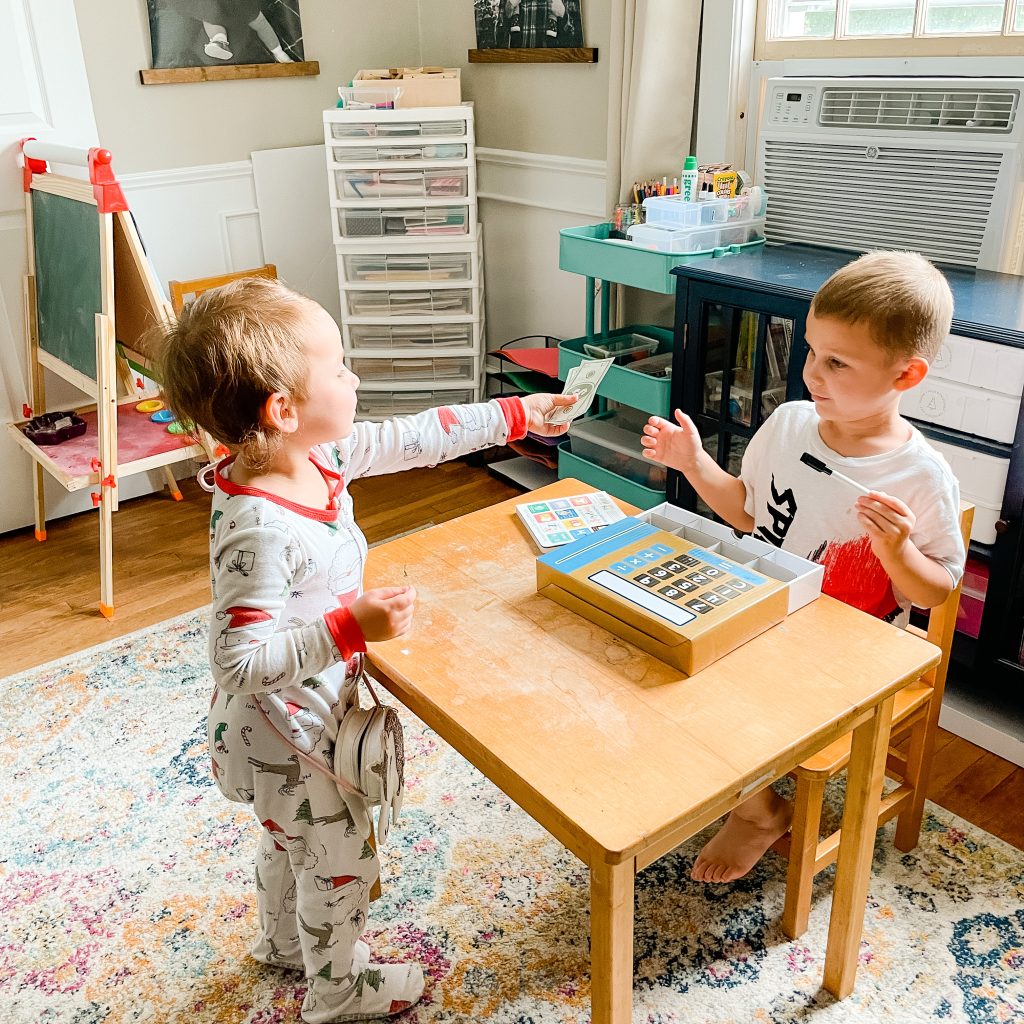A few days ago, I picked up a little cardboard “cash register” in the $3 section at Target. I brought it home, opened it up and left it out on a shelf for my kids to find. My 5 year old noticed it first, took it to a table and set up. He invited my 3 year old to play with him, gave her half the money out of the register and told her that he was selling books at his bookstore. She ran to the dress-up box, chose a purse, put her money inside, grabbed a book off our bookshelf and brought it up to “the bookstore owner” who checked the price on the back of the book, told her what it cost and she reached in her purse, grabbed some amount of money and exchanged her money for the book. They continued this same transaction with different books, for two hours. Over and over again. This is reality-based pretend play.

Montessori has a bad reputation for limiting, and even discouraging, pretend play. Parents are usually shocked when they tour Montessori early childhood classrooms and discover there’s no pretend play corner. Add that to us calling what children do all day work and there’s a whole lot of room for assumptions that Montessori philosophy is too rigid or doesn’t support modern day child developmental research.
The American Academy of Pediatrics defines imaginative play as “an activity that is intrinsically motivated, entails active engagement, and results in joyful discovery. Play is voluntary and often has no extrinsic goals; it is fun and often spontaneous.” I mean, has anything ever sounded more Montessori? 🙂 The truth is Maria Montessori never said pretend play wasn’t allowed, or that guides shouldn’t encourage it to happen. What she said was “the true basis of the imagination is reality”. This, reality-based pretend play is different than fantasy play.
Fantasy play happens when a child’s play is influenced by what the adults around them have taught or shown through books, stories, or mainstream media. Fantasy play includes superheroes and magic potions, dragons, fairies, unicorns, etc. These ideas weren’t thought up by the child. While this type of play is under the umbrella of imaginative play, it isn’t developmentally appropriate for children in the first plane of development — those who cannot tell the difference between what’s real and what isn’t.
Oppositely, reality-based pretend play, is based in reality. Play is rooted in what children know; events and situations they’ve witnessed. They imitate what they’ve seen; actions and dialogue. This is why children gravitate toward playing “house”, or “school” or even “bookstore”. This type of play helps children process the world around them and it also allows them to play out a situation in a playful manner before experiencing it independently for themselves.
I thought I would share some of the reality-based pretend play games my children play along with the items I’ve observed them pair with each game. Again, these aren’t games that I’ve orchestrated, suggested or facilitated but instead, these are imaginative games that are mimicking real life situations my children have observed. I, in turn, observe their play and make notes of what to circle back, too. When they invite me to play, I model the appropriate interactions for each scenario in real time.
– Family: When my children play family/house, they’ll use baby dolls, the kitchen set, and usually have a meal together. Often times, they start by arguing over who’s who. Everyone always want to be the mom and NEVER the baby. This is an ideal time to remind children about different family dynamics! Not every family has a mom, dad and three kids like ours! Sometimes when they play, they’ll have parts for two moms, or two dads — and 0 babies!
– Restaurant: This game almost always results in an actual meal/snack. Someone acts as the host turned server and someone is the diner. They love setting the table, making their own paper menus, and even putting together flower arrangements for the center of the table. If you’re playing too, you can model the generic language used at restaurants and the typical questions that are asked too. That way, the next time you’re actually at a restaurant it’ll sound even more familiar.
– Hotel Concierge (yes, really): This was very popular, pre-Covid since we were staying in a lot of hotels! The kids loved setting up a table like a desk and writing in a notebook. Someone was the hotel worker, who asked the guest what type of room they wanted. Depending on the answer “a big room” or “a room with a TV” or “a room with a big bed” the concierge writes some words down in the notebook and then takes the guest to a different room in our house. This is a good time to model how to treat a guest but also how to treat someone who you are visiting. Sometimes, packing bags is included in this play. Every time the concierge drops off the guest in their room, they say “enjoy your stay”.
– Shopping: We have a small shopping cart which really helps make this game feel more real. They walk around our house collecting items they want to buy. This is a good time to remind children that we don’t buy everything we see in a store! Sometimes we look at things, pick them up and put them right back; sometimes we pick them up and put them in our shopping cart. But we always pay for them and so there’s usually a money component.
Since this is reality-based pretend play, your child might play something completed different based on their own experiences. That’s a beautiful thing! Pretend play allows for creative thinking, language opportunities, grace and courtesy, practical life skills, math skills, executive functioning skills, and so much more. So let’s embrace pretend play in Montessori environments.
Discover more from Jasmine H. Duffy
Subscribe to get the latest posts to your email.